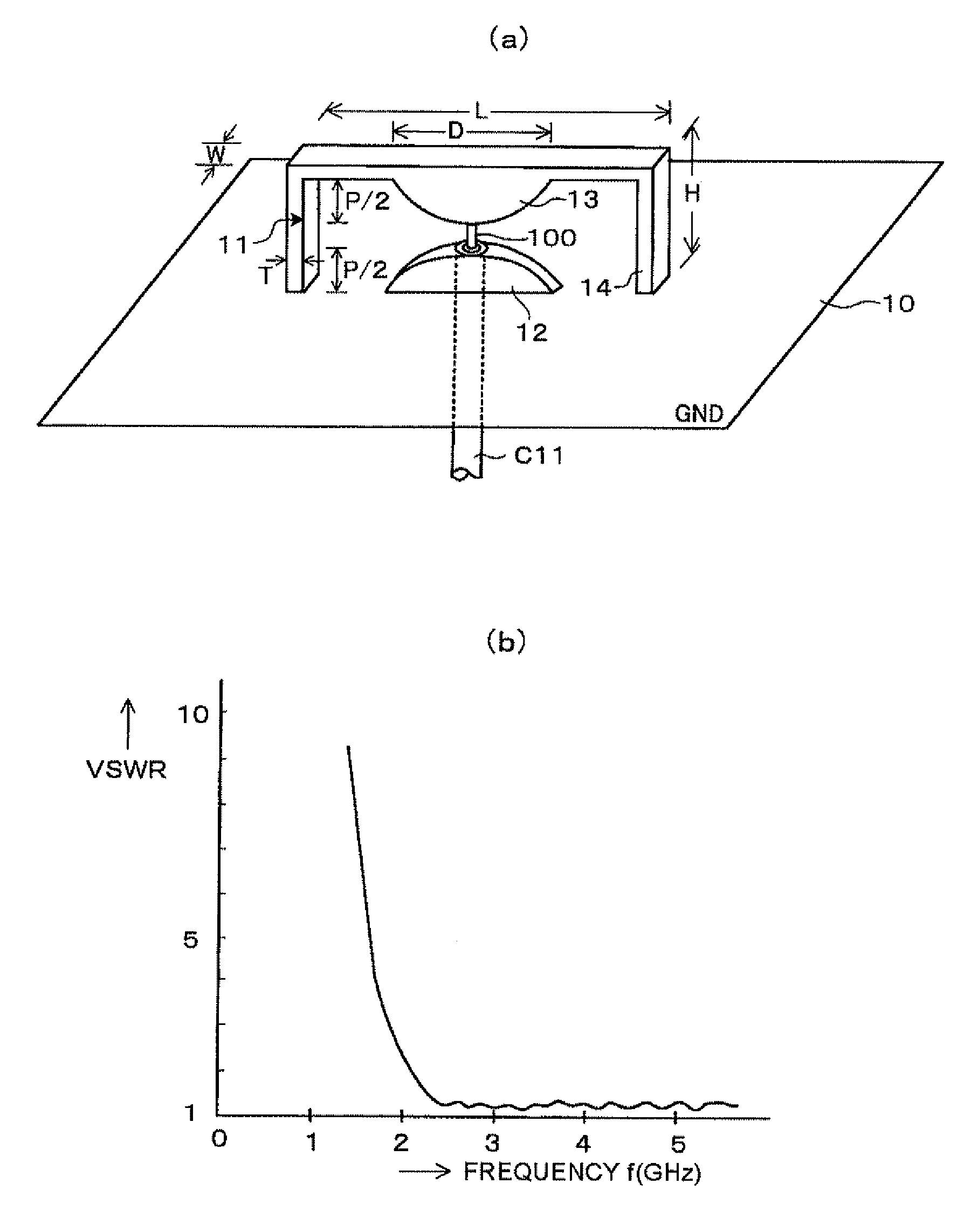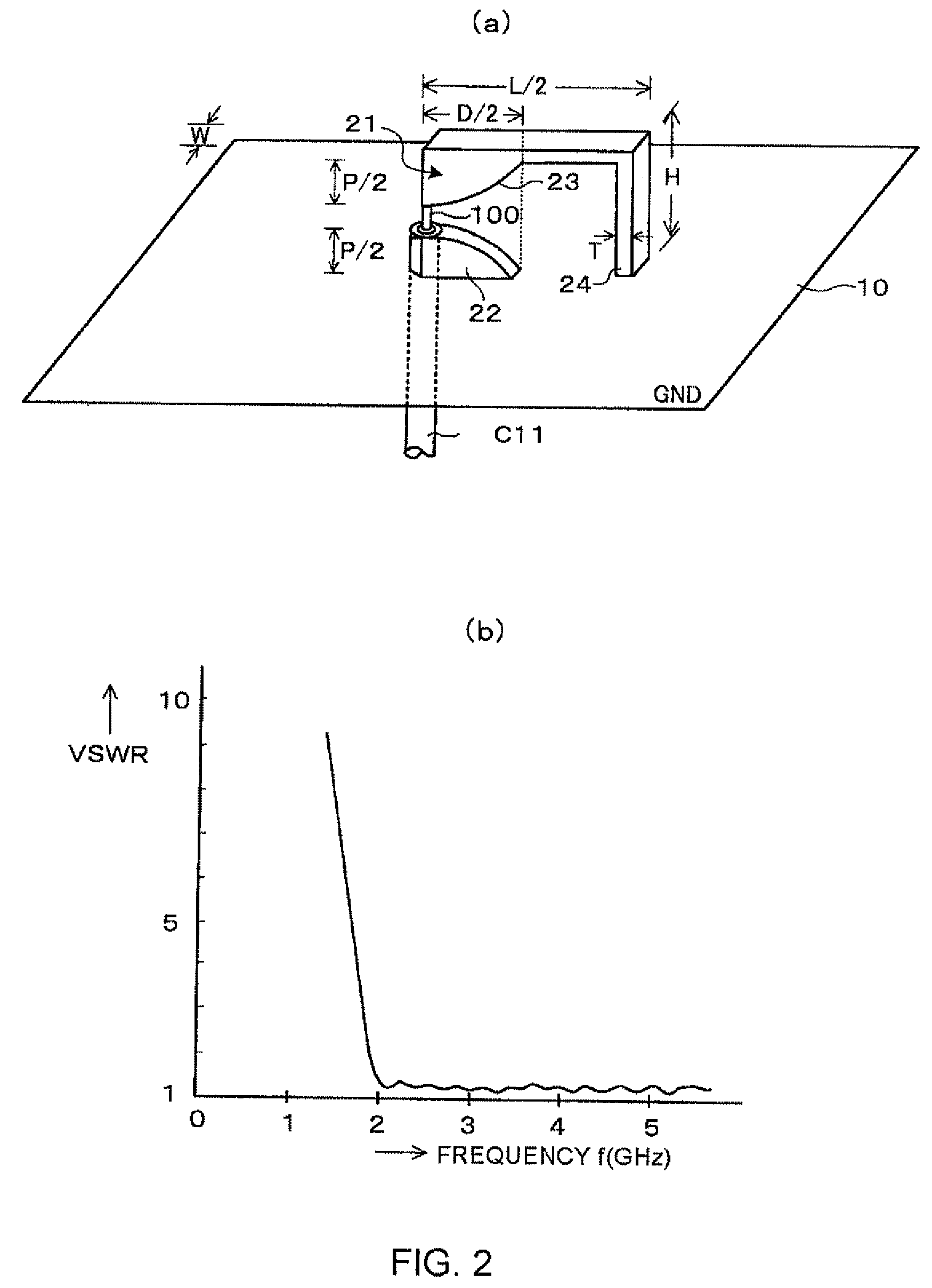Wide band antenna
a technology of wide band antennas and antenna elements, applied in the direction of loop antennas, elongated active element feeds, resonance antennas, etc., can solve the problems of difficult design and adjustment of resonance frequencies, limited directional characteristics of antenna elements, and difficulty in adjusting feed impedance of each antenna element and resonance frequency, etc., to achieve the effect of widening the band of such antennas and enhancing the wide band property
- Summary
- Abstract
- Description
- Claims
- Application Information
AI Technical Summary
Benefits of technology
Problems solved by technology
Method used
Image
Examples
first embodiment
[0046]FIG. 1(a) is an external perspective view of a wide band antenna according to a first embodiment of the present invention and FIG. 1(b) is a graph showing VSWR characteristics. It should be noted here that the VSWR characteristics are one example of the antenna characteristics.
[0047]In the wide band antenna in this embodiment, a double (cylinder) ridge waveguide having a rectangular shape is cut in a tube axial direction at a predetermined thickness and one wide plane is used as the ground plane (hereinafter referred to as the “GND”). This wide band antenna performs an operation in conformity with a mode theory of the double ridge waveguide and includes an antenna element 11 and an auxiliary element 12. The antenna element 11 and the auxiliary element 12 are each made of a metal that is high in conductivity.
[0048]The antenna element 11 forms a shape of a ridge waveguide open cross-section structure together with the GND 10 when it is spread. In other words, the antenna element...
second embodiment
[0056]FIG. 2(a) is an external perspective view of a wide band antenna according to a second embodiment of the present invention and FIG. 2(b) is a graph showing VSWR characteristics.
[0057]As shown in FIG. 2(a) , the wide band antenna in this embodiment has a structure in which a right half of a cross section of a double ridge waveguide is cut out. In other words, the wide band antenna includes an antenna element 21, which has a ridge element portion 23 having a one base end structure obtained by cutting a ridge portion of an upper wide plane in a double ridge waveguide open cross-section structure in its height direction and a radiation element 24, and an auxiliary element 22.
[0058]The ridge element portion 23 acts in substantially the same manner as the ridge portion of the upper wide plane of the double ridge waveguide. The radiation element portion 24 acts in substantially the same manner as a wall of the double ridge waveguide and is used for electromagnetic wave radiation in t...
third embodiment
[0070]Next, an example of a form in the case where the present invention is carried out as a wide band antenna for UWB used in UWB communication will be described. It is assumed that the UWB communications is performed using the GPS, a wireless LAN, an on-vehicle radar, or the like at a communication frequency of 3.5 [GHz] or higher and a VSWR of 2.0 or less.
[0071]In order to facilitate antenna miniaturization, in this embodiment, a radiation element portion of an antenna element is set to form a predetermined angle with respect to a ridge element portion. For instance, FIG. 6 shows a wide band antenna for UWB communications that includes an antenna element 101 and an auxiliary element 102, with a first radiation element portion 104 and a second radiation element portion 105 of the antenna element 101 respectively extending from both base ends of a ridge element portion 103 vertically with respect to the ridge element portion 103 in mutually opposite directions. A tip end of the rid...
PUM
 Login to View More
Login to View More Abstract
Description
Claims
Application Information
 Login to View More
Login to View More - R&D
- Intellectual Property
- Life Sciences
- Materials
- Tech Scout
- Unparalleled Data Quality
- Higher Quality Content
- 60% Fewer Hallucinations
Browse by: Latest US Patents, China's latest patents, Technical Efficacy Thesaurus, Application Domain, Technology Topic, Popular Technical Reports.
© 2025 PatSnap. All rights reserved.Legal|Privacy policy|Modern Slavery Act Transparency Statement|Sitemap|About US| Contact US: help@patsnap.com



